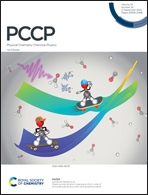Tuning the structural stability and electrochemical properties in graphene anode materials by B doping: a first-principles study†
Abstract
The first-principles method of density functional theory (DFT) is used to study the structural stability and electrochemical properties of B doped graphene with concentrations of 3.125%, 6.25% and 18.75% respectively, and their lithium storage mechanism and characteristics are further studied. The results show that the doped systems all have negative adsorption energy, indicating that the structures can exist stably, and the adsorption energy of lithium ions on graphene decreases with the increase of B doping concentration. Among them, the B6C26 structure has the lowest adsorption energy and can adsorb more lithium ions. The density of states indicates that doping with B can increase the conductivity of graphene greatly. Subsequently, the CI-NEB method to search for the transition state of the doped structure is used, showing that the B6C26 structure has the lowest diffusion barrier and good rate performance. Therefore, these findings provide a certain research foundation for the development and application of lithium-ion battery anode materials.



 Please wait while we load your content...
Please wait while we load your content...